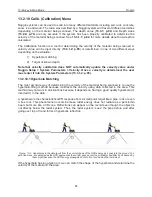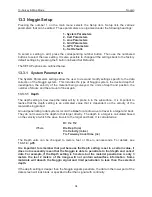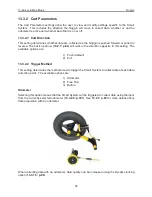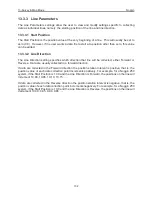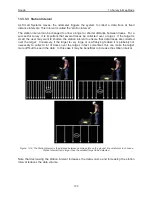
Noggin
13-Survey & Map Mode
99
Free Run
Selecting this option means that the Smart System runs continuously in time, independent of any
other triggering device (
13.2.8: p.84
). The system automatically collects data at regular, user-
determined time intervals. This is called “Free Run” mode and is best for surveys in flat,
unobstructed terrain where antennas can be moved easily. For the position of each
measurement point, the system assumes the operator has moved the antennas one station
interval along the survey line. True position can also be controlled by the user adding markers at
known positions along the survey line and Rubberbanding the data in post-processing.
When Free Run operation is selected, a second menu appears to select the time delay between
data traces. This, along with the number of stacks allow the user to control the speed of the data
acquisition.
The menu prompts the user to input the time delay, in seconds, between each data collection
point. To run the system as quickly as possible, set this value to 0.0 seconds. For a longer time
delay, use the buttons to set the value.
Note that if an external Beeper-Trigger is attached to the system, any time delay longer than zero
(0.0) seconds will cause it to emit a beeping sound to indicate data collection is taking place.
The user can also control the speed the Noggin collects data by increasing or decreasing the
number of stacks (
13.3.1.5: p.96
). Increasing the number of Stacks has the effect of slowing
down the data collection speed of the Noggin system. Decreasing the number of Stacks has the
effect of speeding up the data collection speed of the Noggin system.
The time delay and number of stacks should be set to values that, when combined with speed
the Noggin is moving at, provide an appropriate station interval (
13.3.3.3: p.103
). This may take
a little experimenting to determine the optimal values for stacks, time delay and the actual speed
the Noggin is moving at. To determine the best settings to collect data at approximately the
desired station interval (
13.3.3.3: p.103
), use the calculation described in
13.2.8.3: p.85.
To avoid confusion when collecting data in Free Run, it is usually best to set the Station Interval
to 1.0 so that it the “position” that is saved with each trace is actually the trace number.
Data collected in this manner uses another means of determining the actual position of each
trace, typically by collecting GPS data in parallel or by adding fiducial markers into the data at
known locations during data collection and rubberbanding the data in post-processing.
Summary of Contents for Noggin 100
Page 1: ...User s Guide Copyright 2012 Sensors Software Inc 2011 00022 02 Noggin ...
Page 2: ......
Page 4: ......
Page 8: ......
Page 17: ...Noggin 2 Noggin Components 3 Figure 2 3 Noggin 100 components ...
Page 156: ...Appendix D Instrument Interference Noggin D 2 ...
Page 158: ...Appendix E Safety Around Explosive Devices Noggin E 2 ...
Page 162: ...Noggin G 4 ...




